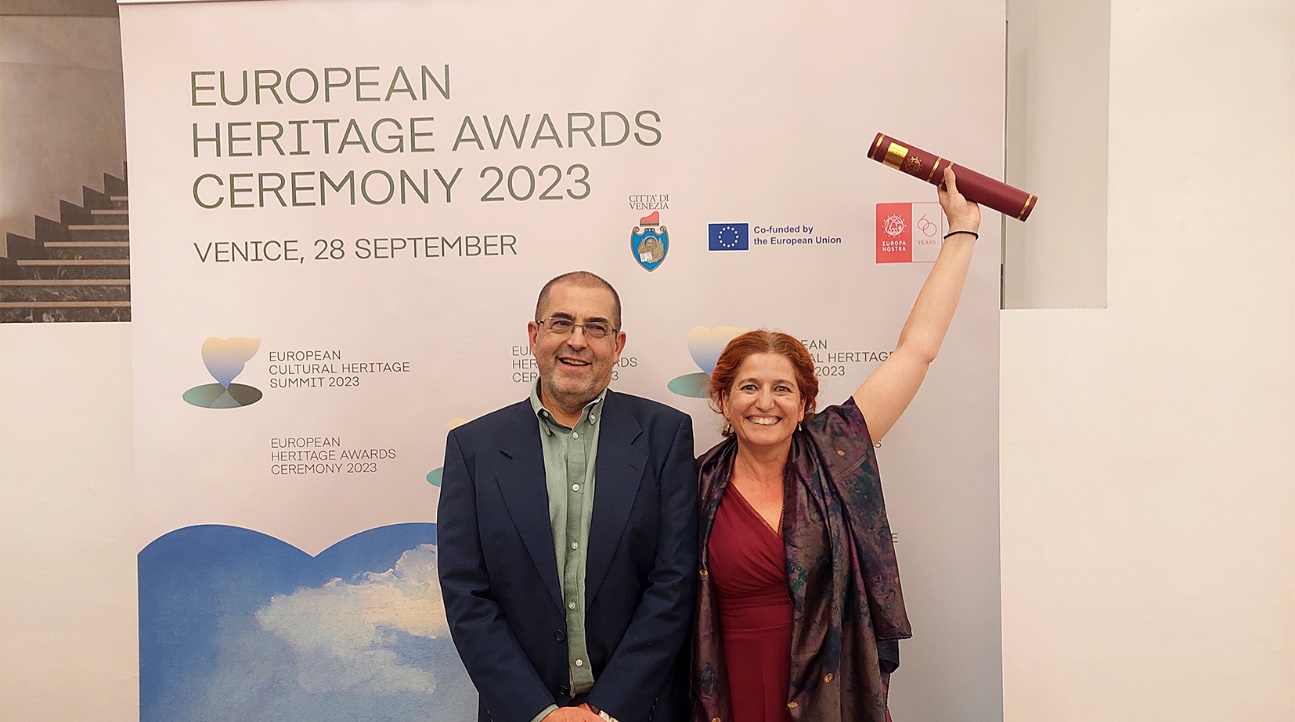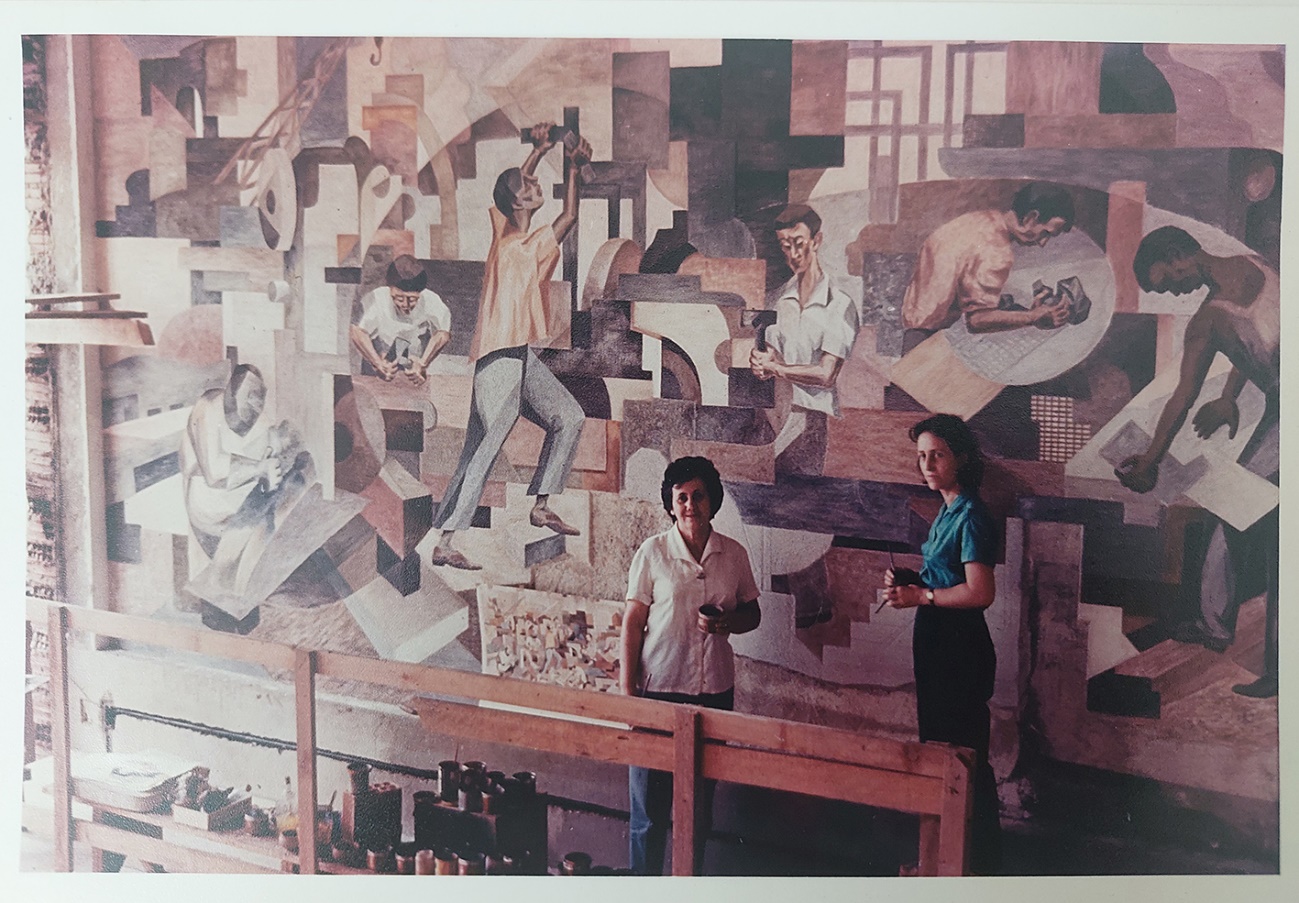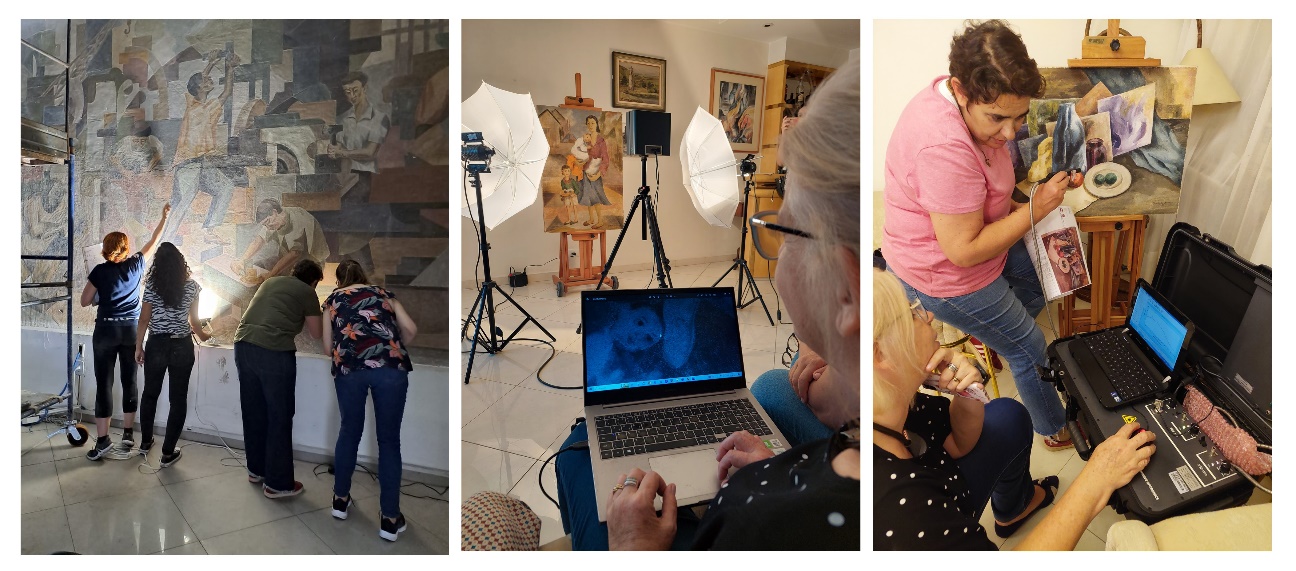|

Dear readers,
The last few months have been full of intense activity in Portugal and abroad. In this newsletter we share the analytical campaigns carried out in August-September, their goals, phases and expected results. We also celebrate with you the EUROPA NOSTRA2023 award, granted in Citizens Engagement & Awareness-raising category. This prize also belongs to everyone who has followed this adventure of unveiling the mural painting art of Almada Negreiros. Thank you!
As always, stay with us and enjoy reading.
Image: Milene Gil and José Mirão at the EUROPA NOSTRA 2023 awards ceremony. Image: Manuel Ribeiro2023-Projeto ALMADA©. All rights reserved.
Highlight
EUROPA NOSTRA2023 Award: ALMADA Project is for everyone, anywhere!
September 27th and 28th were exciting days for the ALMADA project, which received one of the seven EUROPA NOSTRA 2023 awards in the Citizens Engagement & Awareness-raising category. The project's principal investigator, Milene Gil, and the Director of the HERCULES Laboratory, José Mirão, attended the Heritage Excellence Day event, where the project was exhibited, and the European Heritage Awards ceremony, held in the iconic city of Venice, a World Heritage Site.

Figure 1. Photo of the representatives from the 30 projects awarded at EUROPA NOSTRA2023. Image EUROPA NOSTRA©. All rights reserved.
The awards ceremony was hosted by Europa Nostra's Secretary General, Sneska Quaedlieg Mihailovic. Sneska Quaedlieg Mihailovic, and was attended by Cecilia Bartoli, Margaritis Schinas and Roberta Metsola, respectively President of Europa Nostra, Vice-President of the European Commission for the promotion of the European Way of Live and the President of the European Parliament.
ALMADA project of HERCULES Laboratory is among the 30 laureates of this year. The submission entitled ALMADA IS FOR EVERYONE ANYWHERE emphasises the communication strategy of a scientific transdisciplinary project which studies and promotes the mural paintings legacy of ALMADA Negreiros, one of the greatest artist of the modernism movement and avant-garde in Portugal. In figure 1, the official photograph of this year's 30 winners in the five categories of the competition and, in figure 2, the delegation from mainland Portugal after the exhibition of the ALMADA, Arte Xávega and Cláudio Torres projects.
More information about the events can be found online:
Press release with ceremony details in English, French, Italian, Romanian, Spanish, and Ukrainian
Video of the European Heritage Awards Ceremony. The award ceremony for the Almada project can be seen from 1:15:50 pm to 1:25:07 pm
Photos of European Heritage Awards Ceremony
Excellence Day Twitter Thread
Photos from Heritage Excellence Day
Information’s provided by EUROPA NOSTRA

Fig.2. Delegation from mainland Portugal at Heritage Excellence Day, with representatives from the Arte Xávega, ALMADA, Cláudio Torres projects and the National Culture Centre (CNC-Portugal). Image ALMADA project©All rights reserved.
To know
THE ALMADA SUMMER ANALYTICAL CAMPAIGNS IN PORTUGAL AND BRAZIL-ALMADA NEGREIROS (1893-1970) AND GILDA NEUBERGER (1911-2011)
The ALMADA project organized two analysis campaigns over the summer. The first took place in August, just after World Youth Day, at the Church of Our Lady of Fátima in Lisbon. This place of worship, in the heart of Lisbon, is home to Almada Negreiros' first experiments in mural painting, which go completely unnoticed when compared to his greatest work in the art of stained glass [1,2]. It's hard not to be dazzled by the colours, technique and iconographic beauty of stained glass when bathed in light (Fig.3). This church is the starting point for Almada's activity as a muralist painter, as well as for his fruitful partnership with the architect Pardal Monteiro, with whom he would collaborate on the decoration of several other projects in the city of Lisbon, three of which are under investigation in the ALMADA project (Edifício DN and the two Alcântara Maritime Stations).

Fig.3. General view and details of some of the stained-glass windows in the high altar, choir and baptistery of the Church of Our Lady of Fatima in Lisbon. Images MGil2023-Projeto ALMADA ©. All rights reserved
The construction of the Church of Our Lady of Fátima, which began in 1934, is one of the most famous and important examples of the 'golden' decade of Portuguese modernist architecture and the activity of Porfírio Pardal Monteiro (1987-1957) as one of the main authors of public works promoted by the Estado Novo regime [2]. Several Portuguese artists were commissioned to decorate the church, including the painters Henrique Franco de Sousa, Lino António da Conceição and Almada Negreiros. Of the contracts signed with Almada, only the one for the stained-glass windows, dated 6 July 1936, is known, but this artist did work in other materials, including the mosaics, the wrought iron gate that adorn the baptistery and mural paintings [2].

Fig.4 Figuration of the tetramorph by Almada Negreiros. It should be noted that Almada Negreiros mistakenly painted the initials of St Luke in St Matthew and vice versa. MGil2023-Projeto ALMADA ©. All rights reserved.
Almada's mural painting for this space, whose iconographic expression is simpler and more discreet, can be seen in the small dome and ceiling of the church's entrance, in the frieze and dome of the baptistery, and in the frieze that surrounds the high altar. For the latter, Almada painted a tetramorph figuration, made up of the four evangelist apostles Matthew, Mark, Luke and John. An angel, a lion, a bull, and an eagle thus surround the altar of Our Lady of Fatima, separated by gilded grapes and wheat sauces (Fig.4). It was to this set of images that the ALMADA project devoted its attention in order to ascertain the pictorial technique and materials used. These are Almada's first known painted murals and as such are the starting point for understanding his evolution as a mural painter.
For the on-site study, the team used imaging techniques and non-invasive analyses to first characterise the colour palette, technique and stages of execution and diagnosis.
Figure 5 shows the eagle's visible-raking and ultraviolet images, which reveal the coarse texture of the plaster and the fluorescence of the materials originally used by Almada and past interventions. More photographs of the campaign can be found here.
The research of the mural paintings by Almada Negreiros was complemented by two mural paintings of the crucifixion cycle from the nave of the church, by Henrique Franco, and the mural by Lino António on the balcony of the high choir. All three artists have worked on the church's decoration project between 1938 and 1939. The goal of the campaign carried out on-site, and the laboratory work in the coming months, is to explore the points of contact and differences between these artists and investigate possible influences on Almada mural fresco painting work.
Why? Because both Henrique Franco (1883-1961) and Lino António (1898-1974) had artistic training, unlike Almada Negreiros, who was self-taught artist. At the time, Henrique Franco was even a professor at the School of Fine Arts in Lisbon, having already painted a fresco mural in 1936 for the Numismatic Museum of the Casa da Moeda in Lisbon [3]

Getting to know artists similar to Almada Negreiros (Phase 1)
In September, we travelled from Lisbon to Rio de Janeiro and São Paulo, Brazil. This time the focus was on Gilda Neuberger's mural paintings on walls and mobile supports. Gilda Gelmini Neuberger (1911-2011) was a Brazilian artist born in Amparo, São Paulo, daughter of Italian immigrants.
With a multifaceted career spanning over sixty years, the artist began her studies at the National School of Fine Arts in Rio de Janeiro at the age of 22, having been a pupil of Cândido Portinari and Edson Motta in Brazil and Bruno Saetti in Italy. Gilda Gelmini Neuberger was one of the few female artists of the 20th century who practiced frescoes on walls, and perhaps the only one in Brazil who produced frescoes on movable supports and 'false frescoes'.
Among her most emblematic works is the mural entitled 'Homage to the workers', completed in 1963 in the hall of the former Ciferal factory in Rio de Janeiro, now JSL (Júlio Simões Transports e Services). Of recognized importance in Brazilian art, this work in the fresco technique, measuring 3 x 6m, was classified [listed] in the category of historical and cultural heritage by the Rio de Janeiro city council in 1994 (Fig.6).

Fig.6. Gilda Neuberger (left) stands with her assistant next to the mural 'Homage to the workers' during its execution at the former Ciferal Factory in Rio de Janeiro. Photograph family estate©. All rights reserved.
As part of Gláucia Wenzeller's doctoral thesis 'Art and Chemistry: A transdisciplinary characterization in the study of Gilda Neuberger's fresco and false fresco works (1911-2011) ', the aim is to carry out, for the first time, the technical, material, and diagnostic characterization of this mural and to compare it with the fresco and 'false fresco' works on movable supports that are in the family's possession in São Paulo (Fig.7). In a second phase, it is also intended to make comparisons with the work of Candido Portinari and Almada Negreiros. To this end, a two-week analytical campaign was planned, based on imaging techniques and non-invasive analysis. The campaign also included the collection of micro-samples of chromatic layers and plaster (where possible), in order to delve deeper into material characterisation using advanced micro-analytical techniques in the laboratory. Some records of the work carried out can be viewed here.
The field campaign was organized in collaboration with the 'Conservation and Enhancement of Cultural Heritage' project of the Casa de Oswaldo Cruz (FioCruz) and the Physics Institute of the University of São Paulo. The research team included Milene Gil, Teresa Ferreira, Gláucia Wenzeller and Sara Valadas from the HERCULES Laboratory of Évora University; Cristina Coelho and Maria Luísa Carcereri, Fiocruz; Márcia Rizzutto and Wanda Engel from USP.
More news about these comparative studies and interviews with Edson Mota Júnior and Hilda Neuberger will be published on the ALMADA project's social networks and website.

[1] Simão Palmeirim, ‘Decoding a drawing: the stained-glass color sheme of the altar of igreja de Nossa Senhora de Fátima’.
Colour Research&Application, first published in22 september 2023, doi.org/10.1002/col.22901
[2] Natália Correia Guedes e José Manuel Fernandes [coord],
Igreja de Nossa senhora de Fátima em Lisboa 75 anos
. Edição da Paróquia da Igreja de Nossa Senhora de Fátima em Lisboa, com o patrocínio da Fundação Gulbenkian. Março 2013.
[3] https://cultura.madeira.gov.pt/olhares-sobre-o-passado/1816-henrique-franco-de-sousa.html
Acknowledgements
To the Parish of Our Lady of Fátima in Lisbon, in the person of Mr Prior Luís José Alberto and Dr José Cruz for the possibility of the study and for the support of employees Tiago, Conceição, Florêncio and André.
In the Rio de Janeiro campaign, thanks go to the management of JSL Ivandro Paim and Bruno Mota dos Reis and their employees Luiz Guilherme Rocha de Souza and Valbenes Ricardo de Souza for their support. Special thanks to Hilda Neuberger for her warm welcome and availability.
The text was translated to English with www.DeepL.com/Translator (free version).
To listen to
A lively conversation in good company [in Portuguese]
Almada Negreiros project on the TSF radio programe ENCONTROS COM O PATRIMÓNIO, by Manuel Vilas Boas [30 July 2023]. With Rita Almada Negreiros, Inês Cardoso, Guilhermina Rebocho and Milene Gil.
To see
More about the painter Henrique Franco: Guided Tour - Henrique Francisco Franco Museum, Funchal. Episode 18, 15 October 2018, 8th season, Paula Moura Pinheiro programme, RTP.
More about the architect Porfírio Pardal Monteiro - The Architect of Lisbon. Directed by Joaquim Vieira. Produced by Radio Televisão Portuguesa and Nannox
Publications in open Access
. A. Acevedo-Mejia, M. Costa, P. Vandenabeele, L. Dias, J.C. Frade, M. Gil,
'An Insight into the Green Deteriorated Paint Layers of the Maritime Station of Alcântara (Lisbon): An Archeometric Study’,
International Jornal of Conservation Science,volume 14, issue 3, September 2023, pp. 1185-1204. DOI: 10.36868/IJCS.2023.03.27
. K.S. Rix, S. Valadas, I. Cardoso, L. Dias, M. Gil, ‘
Preliminary Diagnostic Survey of Deteriorated Paint Layers at the Maritime Station of Rocha Do Conde De Óbidos, Lisbon: A Multianalytical Research’
, International Jornal of Conservation Science, volume 14, issue 3, September 2023, pp. 1249-1264. DOI: 10.36868/IJCS.2023.03.31
. M. Gil, Y. Helvaci, J. Mirão,
‘Modern Mural Paintings. The Planisphere Painting of Almada Negreiros: Technical and Material Features of Plasters and Painting Technique’,
International Jornal of Conservation Science, volume 14, issue 3, September 2023, pp.1265-1276. DOI: 10.36868/IJCS.2023.03.32
. P.I. Girginova, M. Gil, ‘
Studies of the medium-term effect of nanoconsolidants on wall Paint Layers with a lack of cohesion ‘,
International Jornal of Conservation Science, volume 14, issue 3, September 2023, pp.1205-1220. DOI: 10.36868/IJCS.2023.03.28
Backstage photos
This section aims to show the ongoing research and its participants
Hilda Neuberger is photographed in her flat in São Paulo, sitting with the Portuguese research team next to fresco and 'false fresco' paintings.
Hilda owns more than 300 works created by her mother (Gilda Neuberger) and is looking for support to enhance and safeguard this precious collection.

Foto: From left to right,: Milene Gil, Gláucia Wenszeller, Hilda Neuberger, Teresa Ferreira e Sara Valadas. Project ALMADA2023©All rights reserved.
News published on the website
Project ALMADA at the European Heritage Summit in Venice-Europa Nostra2023
Embracing the mural painting work of Gilda Neuberger (1911-2011)
The ALMADA project's summer campaign
Project ALMADA In Encounters With Heritage
LAST APPEAL FOR THE VOTE OF THE PUBLIC-EUROPA NOSTRA2023
CONGRATULATIONS FROM UNESCO
Project PTDC/ART-HIS/1370/2020 financed by national funds through FCT - Foundation for Science and Technology, I.P.
The images shared in the ALMADA project newsletters are protected by copyright and may not be copied in whole or in part outside the scope of the ALMADA project without the prior authorisation of the authors and descendants of Almada Negreiros.
|
|
|

